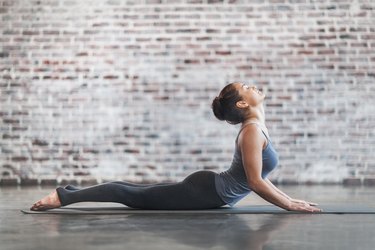
Stretching increases your range of motion and ensures that you can function normally both during exercise and during everyday activities. Different types of stretches exist, and while some may be more beneficial than others, incorporating stretching into your exercise routine helps to improve overall flexibility.
However, you may be experiencing pain while stretching, which can be a sign that you're not stretching properly or be symptomatic of an underlying health condition. No matter the cause, experiencing pain while stretching is not normal and should be a cause for concern.
Video of the Day
Video of the Day
Tip
While stretching can be uncomfortable, it should not cause pain. If you have pain while stretching, you might be causing more tissue damage.
Painful Stretching and Technique
If you're stretching out a muscle group and feel pain in that area, then you may be stretching incorrectly. One of the main causes of stretching pain is pushing your body too far. For example, reaching towards your toes to stretch out your back and hamstring muscles is a common stretch.
However, if you grab onto your feet and continue to pull yourself deeper into the stretch, you may begin to experience pain. This pain indicates you're stretching farther than comfortable and causing damage. A passive stretch such as this one should be done with care. Extend the muscle to the point of mild discomfort and hold for up to 60 seconds, but avoid pushing yourself to the point of pain.
Avoid Overstretching Damaged Muscles
When a muscle sustains damage from an activity or sport, you're going to experience pain while trying to stretch out that muscle. A forearm muscle strain can be caused by overuse and may take a few weeks to heal completely. If you continue to stretch your injured muscles while healing, your pain could continue, and you may also be delaying the healing of that damaged muscle.
However, gentle stretching performed correctly can help you heal from a muscle strain. If you know that you've damaged a certain muscle group, avoid putting any extra strain or stress until it has healed completely. In some severe cases, you may want to seek out medical attention, especially if the pain persists.
Types of Stretching
Your types of stretching may be responsible for pain even if you're not overextending the muscles. One specific type of stretch known as ballistic stretching has mostly been abandoned, but may still be recommended by some. This type of stretching uses the momentum of a moving body or limb, by bouncing into a stretched position, such as bouncing down repeatedly to touch your toes. Because ballistic stretching does not allow muscles to adjust and relax in the stretched position, it may cause tightening and even over-stretch muscles.
Due to its ineffectiveness at increasing flexibility, ballistic stretching is not promoted as a stretching method. You may also be experiencing painful stretching if your muscles are cold or inactive. Passive stretches at the beginning of a workout may be painful if you have not warmed up muscle groups beforehand.
Read more: My Back Hurts More After Stretching
Add Dynamic Stretches
According to an article published in February 2012 by the International Journal of Sports Physical Therapy, both static stretching — holding a stretch for a set amount of time — and dynamic stretching are effective for improving flexibility and range of motion. Dynamic stretching incorporates movements that mimic a specific exercise or movements used in a sport. These movements may be exaggerated, but they are controlled.
Dynamic stretches prepare the muscles and joints in a specific manner for the intended activity or sport. One example is a martial arts performer who uses kicks during an activity. He may perform a dynamic stretch by swinging a straight leg forward to gradually increase the height obtained. These stretches are not jerky and are used with great control, so they are not associated with pain or injury.